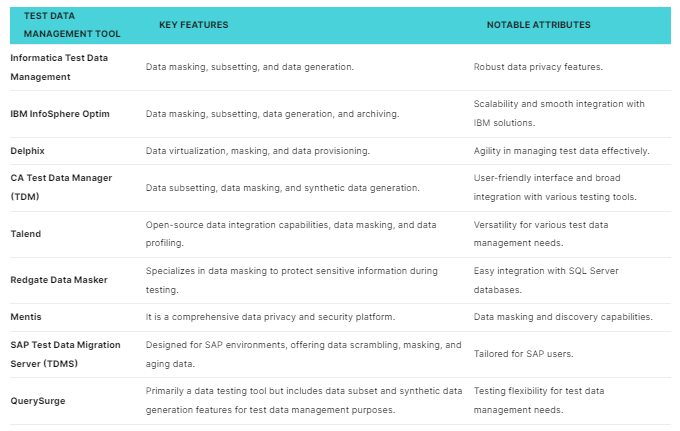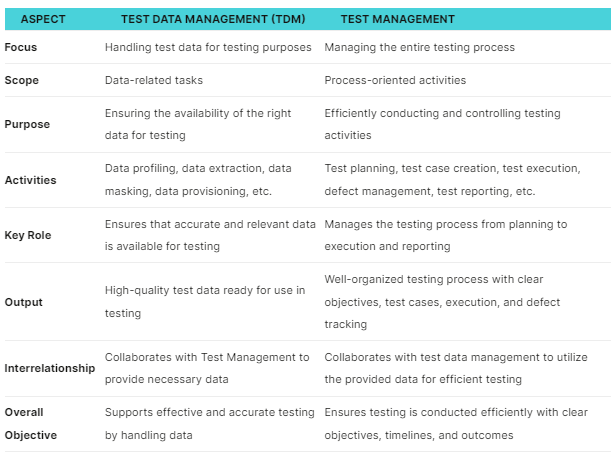Why Test Data Management Can’t Be Overlooked?
 Urwashipriya
Urwashipriya
In an era where software applications have become an integral part of our daily lives, the reliability and efficiency of these applications have never been more critical. Whether booking a flight, managing your finances, or simply browsing the internet, the software running behind the scenes plays a pivotal role in delivering a smooth user experience. But have you ever wondered how developers ensure these apps work without a hitch? That’s where Test Data Management comes in.
Test Data Management ensures flawless performance in our favorite applications behind the scenes. Developers carefully handle the generation and management of test data throughout the development process to evaluate and validate application functionality, making the user experience more effective and reliable.
Need to generate credit card numbers for testing purposes? Use our Credit Card Number Generator tool to generate credit card numbers in seconds. Try it now.
What is Test Data Management?
Test Data Management, abbreviated as TDM, is a software testing process involving the planning, creation, storage, and maintenance of data for testing software applications. It ensures that software testers have access to the “right” data at the “right” time in the “right” format.
Why is Test Data Management Important?
Let’s understand the importance of test data management.
Quality Assurance: Test Data Management ensures that the data used for testing is comprehensive and reflects real-world scenarios, enabling more effective and thorough testing.
Efficiency: It boosts the testing process by providing testers with the correct data at the right time, enhancing their productivity.
Data Security: Test Data Management incorporates data masking and anonymization techniques to protect sensitive information during testing and maintain data security.
Risk Management: By identifying and addressing potential issues during testing, Test Data Management reduces the risk of software failures and security breaches in live environments.
Regulatory Compliance: In industries with stringent data protection regulations, test data management helps ensure testing meets these requirements, using masked or synthetic data when necessary.
Cost-Efficiency: Efficient data management reduces the storage and data acquisition costs associated with testing large datasets.
Looking for a unique username? Generate usernames with our Random Username Generator! Quick, easy, and fun.
Types of Test Data
Test Data is divided into three categories:
Normal Data: Normal data refers to valid input values within expected ranges and formats, ensuring the system functions correctly under standard conditions.
Boundary Data: Boundary or edge data tests a software system’s extreme or boundary conditions.
Erroneous Data: As the name suggests, Erroneous data is intentionally designed to be incorrect or problematic. Testing with erroneous data helps identify vulnerabilities, such as input validation issues or error-handling mechanisms in the software.
Test Data Management Techniques
There are several techniques that have been developed to address the challenges associated with managing test data. Each of these techniques serves a specific purpose to improve the quality and efficiency of the software testing life cycle. In this section, let’s discuss three key techniques that contribute to successful test data management.
Data Masking and Anonymization
Data masking is the method of taking sensitive data in a test environment and replacing it with mock data that mimics the structure and format of the original data.
Anonymization takes data protection a step further by removing personally identifiable information (PII), rendering it impossible to trace back to any individual.
Let’s try to understand Data Masking vs Data Anonymization.
Data masking replaces sensitive details with fake data for secure testing, preserving the structure. Data anonymization goes further, completely removing personal information and ensuring data can’t be traced back. It’s like using a pen name (masking) versus becoming an anonymous author (anonymization).
Why Do They Matter?
Privacy Rules: Data masking and anonymization techniques are necessary to comply with regulations like the General Data Protection Regulation (GDPR) that impose strict data protection standards.
Realistic Testing: Effective software testing requires data that closely mimics real information without the risk of exposing sensitive data. These methods enable the use of realistic yet protected data for testing purposes.
Example: Credit Card Details
Let’s see what credit card details will look like after being masked and anonymized.

In the above table, the masked card number retains some structure. Still, it obscures a portion of the actual credit card digits. The virtual card number used for data anonymization is entirely unrelated to the original data and includes a random identifier for further privacy protection.
Need fake addresses for your testing needs? Try our Random Fake Address Generator tool to quickly generate unique and random fake addresses as many as you want in no time.
Data Subsetting
Data Subsetting is a strategic technique that allows testers to work with concise and manageable segments extracted from a larger dataset during testing for a specific use case.
Why It Matters?
Mitigate Privacy Risks: Data subsetting prevents sensitive or confidential data exposure by creating subsets that include only essential information for testing.
Save Resources: We don’t need to store or handle all the data, which saves space and time, thus improving efficiency.
Example: Social Media App
Suppose a social media platform introduces a new feature designed to improve the digital well-being of teenagers. Let’s say the feature is designed to encourage healthy screen habits and offer educational content at certain times. Instead of testing with the entire user data set that spans different age groups, testers can extract and work with a subset that includes only teenagers.
Synthetic Data Generation
Synthetic data generation crafts artificial data that resembles real-world information, making it a valuable technique in test data management. By doing so, testers can conduct diverse and comprehensive tests, even when real data is limited or unavailable.
Why Synthetic Data Generation Matters?
Data Scarcity: When getting real data is tough (for privacy reasons or other constraints), synthetic data creates a substitute that looks and acts like the real data.
Scenario Flexibility: It enables testers to mimic various scenarios, ensuring thorough testing, even including challenging edge cases.
Data Privacy: Synthetic data is safe since it doesn’t contain real information. This is especially valuable in industries with strict data protection rules, as it eliminates the risk of exposing sensitive data during testing.
Example: Synthetic Data Generation in Country Defense
Imagine a defense organization developing a secure communication system for military personnel. To thoroughly test the system’s performance, the organization generates synthetic data instead of using actual communication logs, which may contain sensitive content that you might not want to use for testing. Following could be the areas where testing is done using synthetic data:
Encryption and Decryption Algorithms: The synthetic data allows testers to assess how well the system’s encryption and decryption algorithm performs with different levels of message complexity and varying encryption requirements.
Network Resilience: The synthetic data incorporates simulated network conditions, such as latency and packet loss, to evaluate how the communication system maintains resilience in challenging environments.
Security Protocols: Synthetic data allows for testing various security protocols, such as authentication mechanisms and access controls. Testers can simulate unauthorized access attempts and assess the system’s ability to withstand potential security threats.
Now that we’ve outlined all three types of test data management techniques, a question arises: how can organizations strike a balance between real and synthetic data?
To answer this question, it is important to understand that a hybrid approach is key to achieving this balance. Organizations can combine real data for critical scenarios while using synthetic data for other testing needs. This ensures realism and security, addressing both compliance and practicality.
Protect your sensitive information with our Hash Calculator. Create secure, one-way hashes in no time and keep your data safe from hackers.
Popular Test Data Management Tools
Test data management tools are designed to address the challenges of test data management. They empower testers to create, organize, and utilize test data effectively, resulting in more reliable and efficient testing processes.

Features of Leading Test Data Management Solutions
To make informed decisions about test data management solutions, exploring their key features and capabilities is essential.
Data Generation: These tools can automatically generate test data, sparing the manual labor of data creation.
Data Masking: Test Data Management tools provide data masking capabilities to protect sensitive information, ensuring data privacy and compliance with regulations.
Data Subsetting: Testers can select and use only the necessary data portions, optimizing efficiency and reducing resource consumption.
Data Refresh: Keeping test data up-to-date is effortless with test data management tools.
Automation: These tools often include automation features, reducing the risk of human errors in test data management.
Reporting: Test data management solutions offer to report features that keep us informed about the status and quality of our test data.
How is Test Data Management Different from Test Management?
Test Data Management focuses on creating and managing diverse datasets for testing, while Test Management oversees the planning, execution, and monitoring of the testing process.
Let’s look at the differences between test data management and test management.

Teams often struggle with version control, sharing test scripts and results, and limited accessibility for remote team members. Get more out of your testing with LambdaTest’s Selenium Cloud Grid, where efficiency meets innovation. With LambdaTest integrations, you can easily synchronize your test scripts, results and data with popular project management tools, ci/cd tools, version control systems and team communication platforms. It is the go-to solution for all your software testing needs, making it easy to handle test cases to get real-time insights and fix bugs quickly. Additionally, you can test websites across 3000+ browsers, devices, and operating systems combinations, so you don’t have to worry about compatibility.
Say goodbye to insecure passwords and unprotected data. Protect your sensitive data with our RipeMD160 Hash Calculator. Generate secure hashes with just a few clicks.
How to Choose The Right Test Data Management Tool?
Choosing the ideal test data management tool is a crucial decision. It can make the testing process smoother and more efficient. Let’s look at some points to be kept in mind before making our ideal choice.
Assess Needs: Identify the nature of the system you are building and break it down based on customer service endpoints. This will help visualize the different dimensions of testing requirements, giving visibility into the kind of data the team needs access to and the volume. Also, check for regulatory compliance.
Check Integration: Ensure that the Test Data Management (TDM) tool is compatible with other testing tools and platforms to prevent disruptions and streamline the testing process.
Prioritize Scalability: Opt for a solution to grow in sync with the organization’s expanding testing requirements. The tools should be flexible to handle increased data volumes, evolving testing scenarios, and additional features as your testing processes advance.
User-Friendly: Select a user-friendly Test Data Management(TDM) tool to facilitate easy adoption by your testing team.
Support and Training: Evaluate the available support and training resources associated with the chosen Test Data Management(TDM) tool. A responsive support system and comprehensive training materials are critical for successful tool implementation and ongoing usability.
Challenges in Test Data Management
Test Data Management (TDM) has several challenges that organizations must address to ensure effective software testing:
Data Privacy and Compliance: Handling sensitive data while adhering to data privacy regulations like the General Data Protection Regulation(GDPR) or the Health Insurance Portability and Accountability Act(HIPAA) is complex and critical.
Data Complexity: Managing large and intricate datasets for testing can be time-consuming and error-prone.
Data Availability: Gathering relevant real data for testing can be difficult, often because of limitations on sharing data.
Data Security: Protecting test data from unauthorized access and ensuring its security throughout the software testing life cycle is essential.
Data Quality: Inaccurate or incomplete test data can lead to misleading results and compromised testing effectiveness.
Need MD2 hashes? Protect your data with our powerful MD2 Hash Calculator that create secure, one-way hashes and make your data safe from prying eyes. Get started now.
Conclusion
To summarize, test data management (TDM) is the best solution to protect sensitive or synthetic data. It’s a secret weapon for data security and world-class software quality. So not only should we recognize its importance, but we should develop strategies around managing the test data effectively. We must realize, that test data management(TDM) is not only an option but a critical factor in developing strong test configurations.
Subscribe to my newsletter
Read articles from Urwashipriya directly inside your inbox. Subscribe to the newsletter, and don't miss out.
Written by

Urwashipriya
Urwashipriya
Urwashi is a passionate software engineer with a knack for crafting elegant solutions to complex problems. With a deep understanding of cutting-edge technologies and a strong desire to share knowledge, she is a dedicated professional in the tech industry. Her expertise lies in creating engaging and insightful blog posts that provide valuable insights into the world of software engineering.